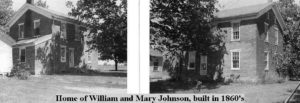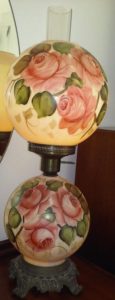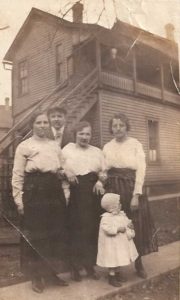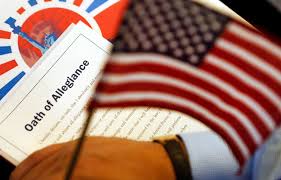My last post, Records Breadcrumb Trail May Lead to Wrong Conclusions, and an earlier post, Circular Migration Patterns-How History Repeats Itself, 30 May 2015) noted my research of my Duer line. My latest hurdle is finding the burial location of John Duer, my 3rd great grandfather.
I know from his Indiana probate records that John died on 25 February 1885 in Adams County, Indiana.[1] John and his second wife, Margaret Martz Searight, were living in Jefferson, Adams County, Indiana in 1880, along with their two children Charley, age 14 and Lucinda, age 12.[2] Adams County, Indiana is adjacent to Mercer County, Ohio where both had resided with their first spouses. I’m descended from John’s daughter, Maria, with his first wife, Mary Jane Morrison.[3]
I’m discovering some interesting information regarding John and Margaret and I wish I could connect up with relatives who might be able to shed light on my findings. The first “odd” event was John and Margaret’s marriage on 11 December 1864.[4] How that is odd is that first wife, Mary Jane, did not die until 10 July 1866.[5] No divorce documentation has been found. Nothing leads me to believe that John was a polygamist; he was raised as a Presbyterian and his father, Thomas, was buried in a Presbyterian cemetery in Trumbull County, Ohio.[6] The Justice of the Peace for the second marriage was a third great uncle of mine on another line, John Leininger. The Leiningers were Lutheran. Since Mary Jane’s tombstone clearly states she was “the wife of John Duer” and there was only one other John Duer living in the area at the time who happened to be her son who was married to a Carolina Kuhn, this isn’t a case of mistaken identity. I’m positive that the John Duer that married Margaret was not John and Mary Jane’s son John (Jr.) as I have his marriage certificate to Carolyn in 1863. John Jr. and Carolina’s first child, John (of course!) was also born in 1866. Likewise, John Sr. and his second wife, Margaret’s first child, Charles, was born in 1866. I haven’t been able to find the exact birth date but remember, first wife didn’t die until July 1866.
If John Sr. and Mary Ann had divorced, why would Mary Jane’s tombstone inscription note her as a wife?

Figure 1Mary Jane Morrison Duer Tombstone[7]
To further support I have the correct John Duer, his will probated in Adams County, Indiana not only mentions his children from his second marriage to Margaret, but Angeline, his youngest daughter with his first wife, Jane.[8]
John and Jane had ten children; at the time of his death six were known to be living. Yet, he did not note any child from the first wife in his will except Angeline.
There could be several reasons for the omission. Perhaps his older children, as well established adults, did not need financial assistance. Maybe there was a falling out and the older children were no longer speaking to their father. Angeline, Mary and James, children from his first wife, were living in Adams County, Indiana while the other children were living in Mercer County in 1870. Although geographically these counties are next to each other, perhaps John decided only unmarried children living in Indiana would receive compensation.
I’ve searched for an obituary for John and Jane and haven’t been able to find one. I’ve also been unable to find where John was buried.
Kessler Cemetery records are incomplete.[9] Jane is mentioned in the records, however, John is not. According to one of the county trustees, the older section of the cemetery has no empty plots. There is an empty space in Jane’s row so it is possible that John was interred there with no stone. If they had divorced, why would he be interred close to his ex?
To rule out a burial elsewhere, other cemeteries in Mercer and Adams counties were examined. No burial location for John was found. John died before death certificates were mandatory in Indiana so there is no clue to be discovered there.
John’s second wife, Margaret, was also buried in Kessler Cemetery and her burial is notated in the records. There are no empty spaces in Margaret’s burial location and all surrounding graves have readable tombstones, very similar to Jane’s. Like Jane, Margaret’s stone denotes her as the wife of John Duer:

Figure 2 Margaret Ann Martz Searight Duer Stone[10]
Margaret was first married to a Mr. Sea(w)ri(gh)te. She had a daughter, Effie, from her first marriage that was born in 1856. Effie was born in Ohio so Margaret had emigrated from Hesse, Germany prior to that time.
I’ve never been able to determine where Margaret’s first husband was buried, either. Oh, these missing men!
Here’s the second odd situation with this family – John and Jane’s daughter, Maria (not to be confused with Mary, another of their daughters) married Henry Kuhn Jr. Henry was also an immigrant from Germany; he was quite prosperous and well known in the German community in Mercer. The Leininger family (the JP for the second marriage) were much like the Kuhns; born in Germany they adapted quickly and held many political offices in the community as well as being successful farmers. Surely these individuals would have all known each other. Maria and Henry’s tombstone is ornate and also in Kessler Cemetery. They could have well afforded a small stone for John. Why doesn’t John have one if he was buried there?
Some individuals do not want a stone but I find no reason that John would have been one of those folks. His father, mother and grandfather had stones, as did both of his wives. It seems to me that his passing wanted to be forgotten.
As I was researching obituaries I came across the following unsettling article:

John’s wife, Margaret, had met a similar fate[11]

Figure 3 The Fort Wayne [Indiana] Daily News
The son that lived nearby was Charles.

Figure 4 The Evening Republican

Figure 5 The Fort Wayne [Indiana] Evening Sentinel

Figure 6 The Indiana Tribune (in German)
John and Margaret’s son, Charles Edward Duer, was married to Almeda Buckmaster.[12] I thought she was the “Mrs. Duer” who had died on 1 June 1894[13]. I began to wonder if there wasn’t a sinister side to this line but I’m happy to report that upon analysis, there were two Charles Duers, one in Indiana and one in Ohio. Both had a loved one die by fire but they were not one and the same. Whew! Thought I was identifying a murder suspect for a bit. Guess it’s just a creepy coincidence!
__________________________________ [1] “Indiana, Wills and Probate Records, 1798-1999,” John Duer, Volume A-C, page 484-486; digital image, Ancestry.com (http: ancestry.com: accessed 16 October 2016), citing Adams County, Indiana Circuit Court.
[2] 1880 U.S. census, Jefferson, Adams County, Indiana, population schedule, page 6 (handwritten), family/dwelling 54, John Duer; digital image, Ancestry.com (http: ancestry.com: accessed 16 October 2016), citing FHL microfilm 1254263.
[3] See previous blogs for citations.
[4] Ohio, Marriage Intention Application, John Duer,
[5] Find-A-Grave, database and image (http://www.findagrave.com: accessed 16 October 2016), memorial page for Jane Morrison Duer (1804-1866), Find A Grave Memorial no. 22503919; memorial created by Teresa citing St. Kessler Cemetery, Chattanooga, Mercer County, Ohio; image by Cousin Becky. Tombstone states “Jane, wife of John Duer” and clearly shows 1866 as the death year.
[6] Find-A-Grave, database and image (http://www.findagrave.com: accessed 16 October 2016), memorial page for Thomas Duer (1775-1829), Find A Grave Memorial no. 57798621; memorial created by BLJns75 citing St. Pricetown Cemetery, Newton Falls, Trumbull County, Ohio. No tombstone pictures but confirmed with a local genealogist in Trumbull who had tripped over Thomas’ fallen stone and had it reset, the cemetery was for Presbyterian’s only.
[7] Find-A-Grave, “Jane Morrison Duer,”
[8] “Indiana, Wills and Probate Records, 1798-1999,” John Duer, Volume A-C, page 484-486
[9] Author to , Mercer County Trustee, Phone and Email, date, . Author is deeply appreciative of for not only scanning and emailing the cemetery records for the Duer family, but including other family members who were interred in the cemetery. Also physically went to the gravesite to verify that there was no stone for John Duer. She took pictures of surrounding stones and emailed to the author. Her dedication is exemplary!
[10] Find-A-Grave, database and image (http://www.findagrave.com: accessed 16 October 2016), memorial page for Margaret A. Duer (1823-1904), Find A Grave Memorial no. 22546617; memorial created by Teresa citing St. Kessler Cemetery, Chattanooga, Mercer County, Ohio; image by Cousin Becky.
[11] “Burned in Her Home,” The Fort Wayne [Indiana] Daily News, 29 December 1904, p. 1, col. 3.
“Aged Woman Cremated,” The [Columbus, Ohio] Evening Republican, 30 December 1904, p. 1, col. 2.
“Aged Woman Burns to Death in Home,” The Fort Wayne [Indiana] Evening Sentinel, 30 December 1904, p. 1, col. 3.
“Radridten and Indiana,” Indiana Tribune, 30 Dec 1904, No. 110, p. 1, col. 6.
[12] “Indiana Marriage Collection, 1800-1941,” Charles E. Duer and Elmeda Buckmaster, 6 March 1886; digital image, Familysearch (https://familysearch.org: accessed 17 October 2016); citing FHL microfilm 002321466; citing Adams County, Indiana County Clerk Office, p. 124.
[13] “Fatal Burns,” The Lima [Ohio] Times-Democrat, Vol. X, No. 195, p. 1, col. 1.


















